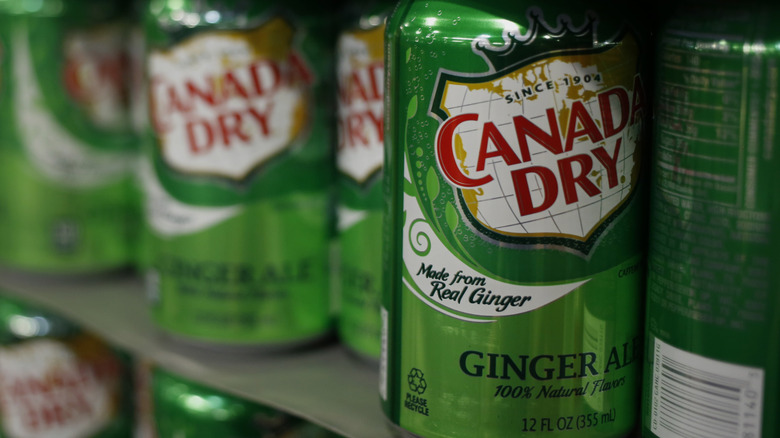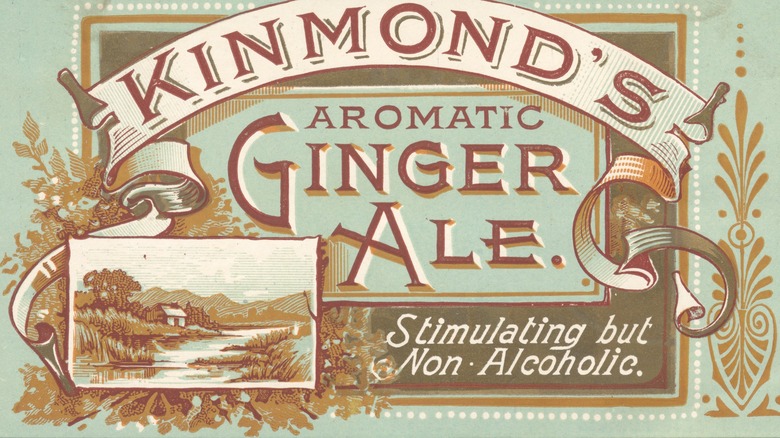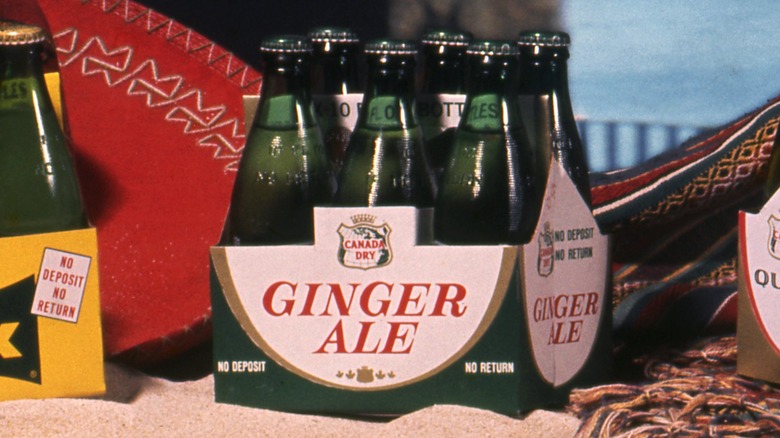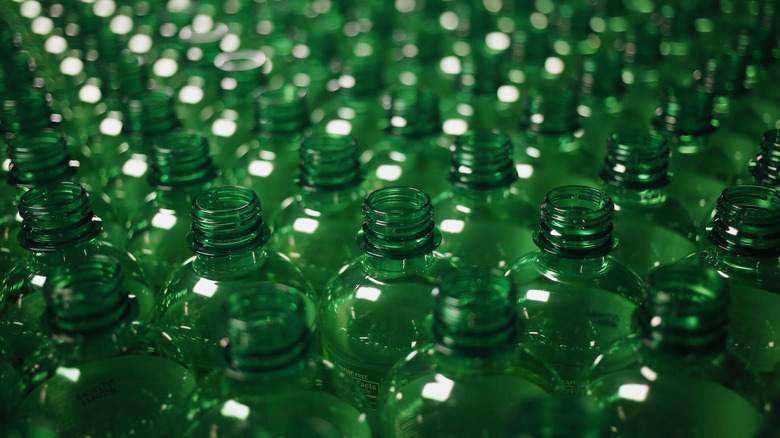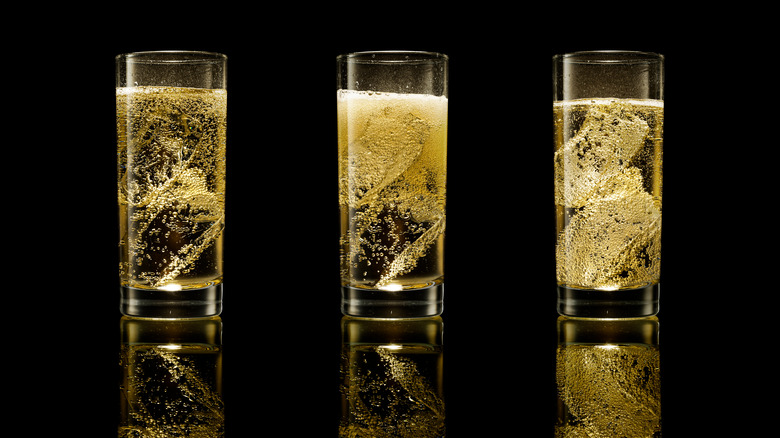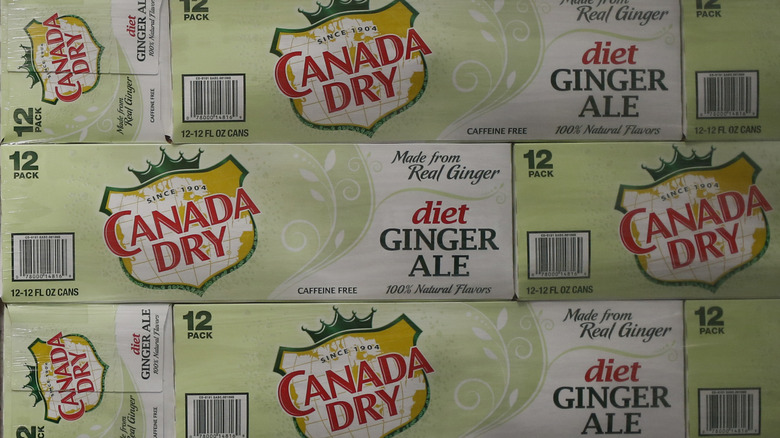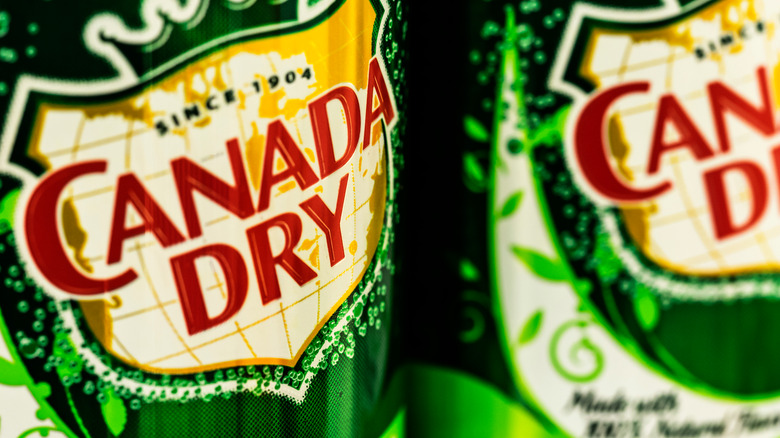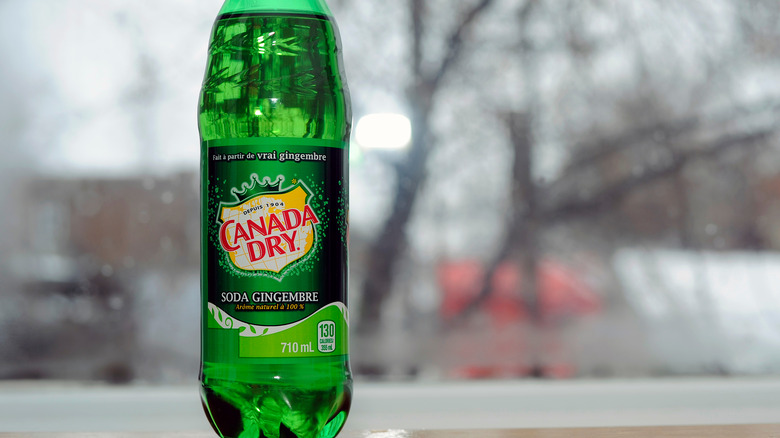The Untold Truth Of Canada Dry
Every country and culture on the planet has a proud culinary tradition. Indeed, some of those foods and beverages are so delicious that they can make their way to nearly every corner of the world, where they can be rightfully enjoyed by millions, if not billions, of people. Now, Canada is a relatively new country, scarcely more than 150 years old. But it boasts a food scene that reflects its natural resources — maple and fish figure heavily, of course — as well as its diverse combination of cultural influences, including indigenous First Nations peoples, as well as European settlers and immigrants from other nations.
When it comes to tasty things, Canada is probably the most famous around the world for its Tim Hortons doughnuts, the delicious fries-gravy-cheese pile called poutine, and ginger ale — particularly Canada Dry's particular formulation of the spicy, sweet soft drink and classic cocktail mixer. As a company, Canada Dry has been churning out ginger-flavored beverages (and other sodas and alcohol mixers) for more than a century, both in Canada and beyond. Here's the zesty story of the company behind some seriously zesty beverages that made fortunes and even defied Prohibition. This is the untold truth of Canada Dry.
Before there Canada Dry, there was ginger beer
Born to Northern Irish immigrants in 1865 in the British colony of Upper Canada, John J. McLaughlin didn't seem set to become a drinks magnate. Instead, he graduated from pharmacy school and worked his way through more training in New York while also working as a soda jerk in a large Brooklyn pharmacy (per the Dictionary of Canadian Biography). This was the 1880s, when the soda craze was just kicking off in the United States. At that point, carbonated soft drinks were seen as both medicinal elixirs and tasty treats, often served up as a combination of bubbly mineral water and flavored syrups packing in the sugar and caffeine. They were primarily dispensed at soda counters in pharmacies and drugstores, and so McLaughlin decided to combine his experience in pharmacy and soda-making. In the early 1890s, he returned to Toronto to start his own line of bottled soda water.
Advertising his products as safer to drink than what was available via the municipal water supply, McLaughlin marketed his bubbled concoctions in flavors like lemon, cream soda, cola, and, most notably, according to BlogTO, McLaughlin's Belfast Style Ginger Ale. According to ThoughtCo, McLaughlin took much of his inspiration from ginger beer, a 19th-century alcoholic drink that had been developed and became popular in the British Isles. By the 1850s, people in Ireland (McLaughlin's ancestral home) were consuming ginger ale, a booze-free, sweetened, dark brown-colored, ginger-flavored soda water that clearly inspired McLaughlin himself.
Canada Dry took off after a dramatic reformulation
In 1904, after about a decade of helping to popularize ginger ale in Canada, John J. McLaughlin (per the Dictionary of Canadian Biography) decided to change just about every aspect of his company's signature beverage. According to the website of his future company, McLaughlin thought that the ginger ale market had grown overly saturated with syrupy, extra-sweet ginger ales. Thinking consumers might want something lighter, he did away with McLaughlin's Belfast Style Ginger Ale and came out with the comparatively light and crisp Canada Dry Pale Ginger Ale.
In ads from the time period, McLaughlin likened the product to champagne, in that it was similarly dry (meaning that it wasn't full of sugar and therefore overwhelmingly sweet) and pale, meaning that it was lightly colored. To really get the other half of the product's name across — that would be the Canada part — McLaughlin put a map of Canada and a beaver on the cans. It must have played pretty well to the consumer. Within two years, the new and improved ginger ale was so popular in Canada that McLaughlin had to open production facilities in Winnipeg and Edmonton (joining the one already operating in Toronto).
Canada Dry made it to the U.S. at the perfect moment
According to the Metropolitan News-Enterprise, Canada Dry was so profitably ensconced in Canadian culinary culture that it expanded southward in 1919, shipping bottles of its very popular ginger ale into the United States for the first time. That would turn out to be excellent timing, because the period in which the manufacture, free sale, and distribution of alcoholic beverages in the United States known as Prohibition began in January 1920, per History. With the ban on booze taking hold in the U.S., soft drink production and consumption naturally rose in response.
By 1921, a mere two years after introducing its product to the U.S. market, Canada Dry responded to its ginger ale's quickly rising popularity by opening a bottling plant in New York City. According to contemporary syndicated news articles in 1927 and 1928, ginger ale eventually grew into a billion-dollar industry — and a lot of that was because of the increasingly popular Canada Dry and the restrictions imposed by teetotaling Prohibitionists. For Americans who wanted to behave themselves in accordance with the law, Canada Dry and other soft drinks were a decent alternative to alcohol.
Canada Dry helped many Americans drink illegally
While millions of Americans took up a ginger ale habit as an alternative to drinking increasingly difficult to source alcohol during the Prohibition Era, a significant portion of Canada Dry's 1920s sales were from people using its flagship drink as a mixer, according to the Metropolitan News-Enterprise. Illegally produced alcohol was often made in small batches, necessarily done so on the sly. The black market hooch was also produced with little heed for quality control or consistency. The result: Much of the liquor available in shady back channels or in speakeasies (illegal bars) had a terrible, nearly unbearably bitter taste.
But, drinkers knew just what to do to help manage that questionable flavor. The not-too-spicy, not-too-sweet flavor of Canada Dry Ginger Ale apparently cut right through all the nastiness to create a relatively tasty, layered alcohol concoction. As a result, a mixture of gin and ginger ale became one of the most popular cocktails of the Prohibition Era. Alcohol was re-legalized in 1933, taking the pressure off and hopefully restoring some quality to the gin, but ginger ale remained as a mixer. In fact, it's still sold in liquor stores or stocked near the tonic water and other adult drinks in grocery stores today.
Canada Dry helped to pioneer diet soda
The first "diet" sodas — meaning those drinks that are meant to be calorie-free and made with sugar alternatives — were geared toward people with medical conditions that precluded the consumption of sugar, primarily people with diabetes. According to Culinary Lore, the very first proper diet soda didn't debut until the mid-20th century. Hyman Kirsch, a Russian immigrant and Vice President of New York City's Jewish Sanitarium for Chronic Disease, was inspired by his diabetic and cardiovascular patients in 1952 to formulate No-Cal, a line of sodas in which the first flavor available was ginger ale. Before long, two million cases of No-Cal were selling each year, mostly in New York and Washington, D.C. But it was still enough for "Big Soda" to take notice, as larger companies began making their own diet sodas.
In 1954, Canada Dry became the first major soft drink manufacturer to launch a line of diet sodas. Canada Dry Glamor boasted zero calories and no sugar. Its print ads were directed at women, urging ladies to "stay slim" with "non-fattening sugar free" Glamor, which came in massive quart-size bottles in flavors like "Ginger Drink," lemon, root beer, orange, and black cherry. Glamor was also available in cola, meaning Canada Dry arguably beat Coca-Cola and PepsiCo to the market; their TaB and Diet Pepsi offshoots didn't hit store shelves until 1963 and 1964 respectively.
The complicated corporate history of Canada Dry
It's been a very long time since Canada Dry was under the purview of the small team of John J. McLaughlin and his close associates. By the late 1960s, according to the New York Times, Canada Dry belonged to Norton Simon, a diversified holding company formed out of the merger of Hunt Foods, the Glass Containers Corporation and the United Can Company, and McCall's, a magazine publisher. Under this arrangement, Canada Dry acted as a subsidiary of Somerset, a bottler and importer of wine and hard liquor. In 1981, Norton Simon sold off Canada Dry (at the time the seventh-biggest soft drink producer) to The Dr Pepper Company, which instantly became the third-largest soda company, pulling ahead of 7UP.
According to the Los Angeles Times, in 1984, investment firm Forstmann, Little & Co. purchased Dr Pepper, then turned around and immediately sold Canada Dry to tobacco company RJ Reynolds Industries (per the New York Times), making the soft drink bottler part of its Del Monte Foods division. Just two years after that, Canada Dry (via the New York Times) was sold to British company Cadbury Schweppes. That meant one company made two of the world's biggest ginger ale brands which were once great rivals: Canada Dry and Schweppes.
These days, Canada Dry is again under the same corporate umbrella as Dr Pepper. It's part of the more than 100 brands controlled by rather massive Keurig Dr Pepper conglomerate.
How much ginger is really in a can of Canada Dry?
In recent years, Canada Dry became embroiled in a legal mess over claims merely suggested by a mere four words printed on its ginger ale cans. In 2018, according to Food & Wine, a Canadian man named Victor Cardoso led a class-action lawsuit against Canada Dry's Canadian subsidiary. Cardoso, his spouse, and their children became heavy consumers of the company's ginger ale because the slogan "Made From Real Ginger" was written on the can. This text led them to assume that the product offered significant, positive health benefits, especially given that regularly consuming this rhizome has some pretty well-documented and healthful effects on one's body.
And while there is technically ginger in Canada Dry ginger ale, Cardoso's lawyer, Mark Canofari, argued that the company shouldn't advertise the benefits of ginger because of the way it was handled in the production process. "They do buy actual ginger, but then what they do is boil it in ethanol, and that essentially destroys any nutritional or medicinal benefits," Canofari said in describing how Canada Dry makes its ginger concentrate. Furthermore, Canofari alleged that it's all pretty diluted, anyway. "One drop fills 70 cans," he said. "So that's how little, even of the concentrate, is actually in one drink.
After nearly two years of legal battles, per CTV News, Canada Dry settled the lawsuit for $200,000 but denied any wrongdoing. It also didn't have to change its labeling or advertising practices in Canada.
